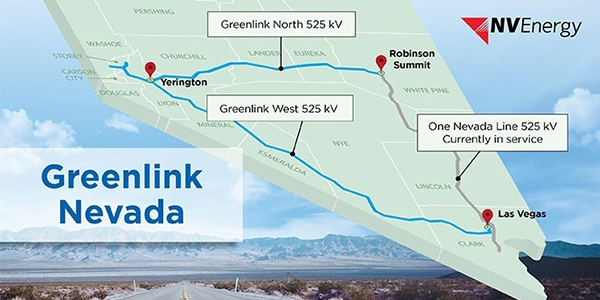The Public Utilities Commission of Nevada on Monday approved NV Energy’s request to build a 525-kV transmission line from Las Vegas to the northern part of the state.
The project, Greenlink West, is the first phase of the utility’s $2.5 billion Greenlink Nevada initiative. In addition to a 350-mile, 525-kV line from Las Vegas to Yerington, Greenlink West includes two 345-kV lines from Yerington into the Reno/Sparks area. NV Energy estimates that Greenlink West will be completed by December 2026.
Planning is also underway for Greenlink North, a 525-kV line that will span about 235 miles from Yerington to Robinson Summit near Ely. PUCN approved the conceptual design, permitting and land acquisition for Greenlink North; NV Energy will return for approval of construction.
The Greenlink projects would complement NV Energy’s existing One Nevada line, which runs through eastern Nevada from Las Vegas to Robinson Summit. The three lines would join together to form a triangular transmission network.
Economy and Clean Energy
NV Energy said Greenlink Nevada would have many benefits, such as increasing electric reliability, creating jobs and helping the state’s economy recover from the COVID-19 pandemic, the company said.
Greenlink Nevada would also help the state meet its clean energy goals, NV Energy said. At least half of electricity sold to retail customers in the state must be from renewable resources by 2030.
“Greenlink Nevada will transform Nevada’s clean energy landscape by tapping into resource-rich renewable energy zones throughout western and northern Nevada, helping accelerate the responsible development of clean energy on public lands,” NV Energy said in a news release on Monday.
PUCN agreed that enhanced transmission is needed.
“These [renewable energy] goals cannot be achieved without opening up the state such that renewable energy resources can be accessed from all areas of the state — and that can only be accomplished by expanding the existing transmission system,” the commission said in its order approving construction of Greenlink West.
“Additionally, the economic benefits which are desired from decarbonizing the state’s electrical energy needs are not going to materialize solely by importing large amounts of renewable energy from out of state.”
NV Energy said in its application to the PUCN that the West is the only U.S. region without a regional transmission organization. Utilities and state officials are starting to realize that an RTO might be necessary in order to meet the requirements of renewable portfolio standards, the company said.
“Whether the companies eventually join an RTO or not has yet to be determined,” NV Energy said. “But the Greenlink Nevada plan creates the type of electrical network required to make Nevada a major hub in the western market.”
Project Phases
NV Energy had initially planned to build the Greenlink North transmission line first, with Greenlink West to follow. But constructing Greenlink West first would bring benefits to the state more quickly, the company determined.
In particular, Greenlink West would eliminate the single contingency of the One Nevada Line and result in a larger immediate increase in import capacity than Greenlink North, the company said in its application to the PUCN.
The project would also provide access to more solar resources in Nevada and boost economic investment into the state sooner, NV Energy said.
Although NV Energy sought a critical facility designation for Greenlink West, the commission declined to grant it. The designation would have allowed NV Energy to incorporate construction work in progress into its rates.
Unlocking Benefits
Nevada Gov. Steve Sisolak tweeted his approval of the commission’s decision, saying the line “will unlock for all Nevadans the sustainability and economic benefits that come from providing essential transmission access to our State’s vast renewable energy resources and exemplifies the potential of my vision for NV’s new energy economy.”
Environmental group Western Resource Advocates (WRA), a vocal advocate for creating an RTO in the West, also welcomed the decision.
“The transmission buildout will provide economic development and ratepayer benefits for Nevada and beyond, by providing the infrastructure to connect renewable energy resources for import and export across the West and opening up economic opportunities for Interior West states to market their renewable resources to West Coast states while improving efficient use of energy resources across the region,” Cameron Dyer, WRA staff attorney in Nevada, said in a statement.




